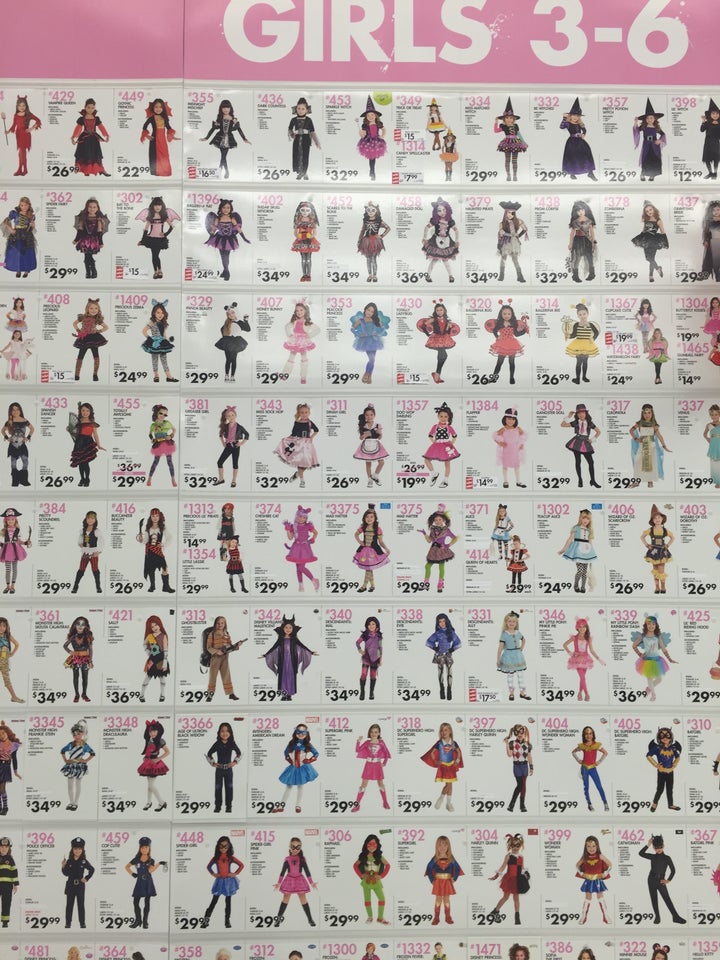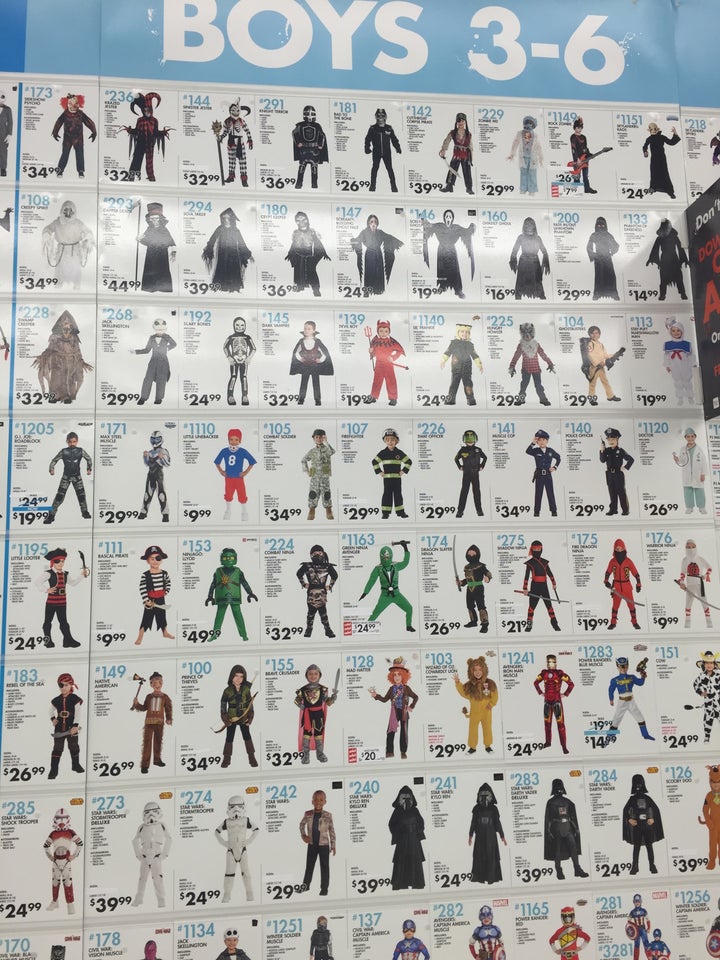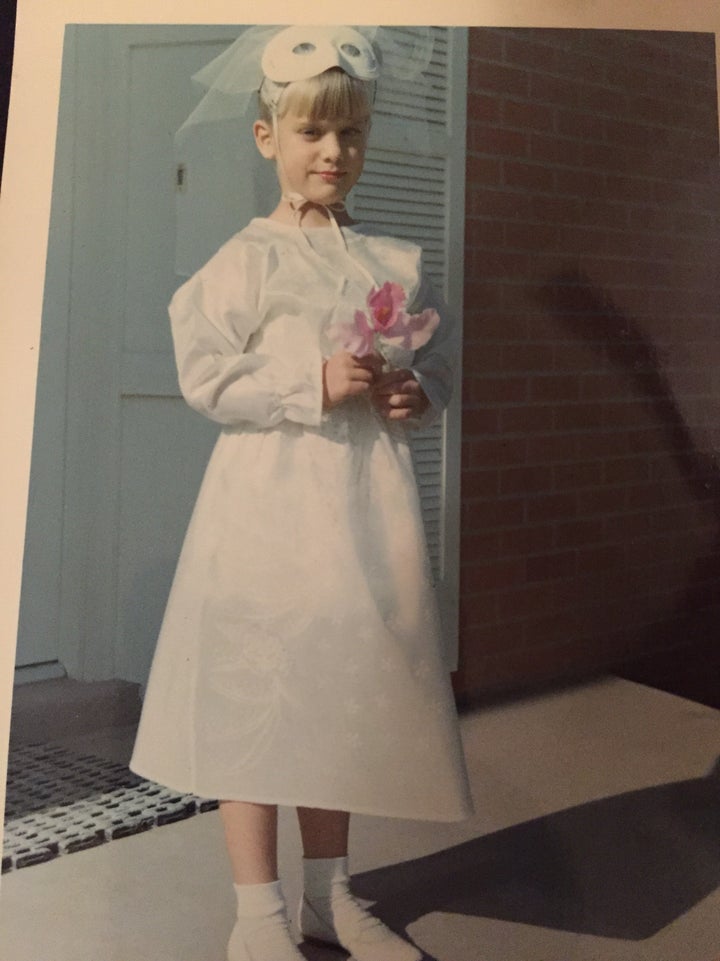
Girl’s Costumes, Ages 3-6, Party City, October 2016
Given that it was the weekend before Halloween, Party City wasn’t as crowded as I thought it would be. Gripping my almost-three year old daughter’s hand, I quickly steered us past the brightly-colored containers of candies – past the withered, photoluminescent-green faces of witches, the cotton candy-textured spiderwebs and plastic broomsticks, and the motion-activated demons – past everything that might be distracting or tantrum-evoking, and towards the wall of costumes.
“Those are scary,” she said, stumbling from tip-toe to side-of-foot, brushing up against one of the life-sized porch witches. The witch’s angular face and coarse grey hair glared skeletally, memento mori.
Just past the witches, and we were there: Party City’s wall of pictured costumes, arranged by age and gender, the meager INFANT section on the far right the only unisex category. A man with small, plastic fire helmet – only half the size of the top of his head – paced along the wall’s expanse, speaking into a headset to the stockroom employees, where the actual costumes were being stored. Across the fluorescently-lit wall were evenly-spaced, rectangular images of each costume, organized by code number. As I searched for the Toddler Girls section, my own toddler raced to the wall, sandwiching palm to plastic-lined ad.
“One, two, three,” and she was off, counting row after row, mixing together fifteen and sixteen as always, letting out a congratulatory “yay” after reaching twenty, and I finally found it, smack-dab in the middle: GIRLS 3-6.
It was one of those rare, literal double-takes: I looked left, right, and back again at what was in front of my face. From a distance, the GIRLS 3-6 looked mislabeled, but up close it became clear these were, in fact, children, and not teens or adults. Toddler aged girls wore thigh highs and tulle tutus that were inches above their knees. They jutted their minute hips, their baby arms akimbo. Parents could dress their daughters as a “Panda Beauty,” “Honey Bunny,” “Pretty Scoundrel,” or “Cop Cutie.” Essentially, “Pretty,” “Cutie,” and “Beauty” were the toddler equivalent of “Sexy”: that is, “Sexy Librarian” was translated into “Librarian Cutie.”

“Finding everything okay?” Mini Fire Helmet seemed so genuinely interested in helping my little smiling counter find a costume that I redoubled my efforts to find at least one palatable option.
“Maybe Elsa, or Anna?” I offered, pointing out the well-known Disney franchise characters. But, with a squeal, she ran towards the rainbow colored face-paints and face masks—past the stressed-out man on his cell, and towards the teenaged girls who were busy giggling and sizing up wigs. She was not interested.
I shrugged, gave my best “Oh, Kids!” expression, but felt utterly perplexed. Should I choose from BOYS 3-6? Stick with one of the less obscene GIRLS 3-6? Get a big INFANTS animal costume or pumpkin? DIY it? Rush order something from Amazon? My choice seemed laughably – undeniably – trivial in the scheme of things: but, at the same time, something felt direly important about what kind of costume I chose. But what, if anything, could it mean if I chose “Pretty Scoundrel,” or Elsa, or Hello Kitty, or a doctor, or a home-made freight train? Am I fighting the good fight against patriarchy, or just patting myself on the back for being “different”?

Boy’s Costumes, Party City, October 2016
We generally understand Halloween as being a kind of rite of inversion – a Mardi-Gras-ish form of organized disorder, where cultural conventions and structures are playfully turned upside down. Yet, in so many ways, cultural conventions are hyperactively inscribed during this time of supposed subversion. Girls can be pirates, but, by God!, they have to be pretty pirates. Or, on the flip side, girls can’t be something trivializing or objectifying; they need to dress as something that will express their inner worth: that will show that girls, like boys, can do things, not just look like things. It’s the classic Foucauldian twist. Something external and visible becomes internal and invisible: my costume reflects my innermost self.
My all-time favorite Halloween costume growing up was a pre-Pinterest DIY: I was a Christmas present. My mom, younger than I am now, already busy with three children and on her way towards the fourth, was painstaking, detail-oriented. She carefully measured out head, arm, and leg holes, transforming pencil-marked, discarded cardboard boxes into the joy of Christmas morning.
“When you wrap a present, you want clean edges,” she’d say, showing us how to line up the edges on the back of the gift. How to cut the paper just so, fold it at the base, smooth it down. Pull the ribbon around, use scissors to get the perfect curl.
Years later, flipping through weathered photo albums, my mom and I stumbled across a forgotten Halloween costume of her own.
“Oh, this is sad,” she said. White masked, a diaphanous veil, her white-blonde hair in a tight elaborate bun, my mom held a faux bouquet of pink flowers. She was a bride.

What disturbed me wasn’t just that the costume suggested that a woman’s largest ambition was marriage (although, yes, that was disturbing). It was that uncanny resemblance between us: we were decades apart, tiny children not yet fully imprinted with cultural expectations, but both on our individual paths to learning from the gospel of Seventeen Magazine and Cosmo. How to tweeze your eyebrows, remain obsessively aware of every hair follicle on your body. How to look effortlessly flawless after hours of covert effort. How to transform his fleeting sexual desire into everlasting love. How to become the perfect present.
#
Back at Party City, in between Hello Kitty ballerinas and some kind of Strawberry Beauty, I had it. My daughter could be Pikachu, and I’d be a kid/millennial/hipster glued to my phone playing Pokemon Go. It would be the perfect mix of cuteness overload and light-hearted, soft-ball cultural commentary. A quick google search later, the idea proved to be not entirely unique, but still. I was ready to call it quits, and my daughter seemed to enjoy saying Pikachu. When I pulled up a clip on youtube, she and I were sold.
“Oh Pikachu?” Mini Fire Helmet scrunched his brows thoughtfully. “I think we had that in Boys, but we’re out of stock. No, wait, here it is!”
He brandished the boxy yellow form of Spongebob Squarepants with glee.
“Is this it?” No, it was not it: but, yes, we’d find a kid’s small Pikachu shirt that would work fine. Yes, the right face-paint and Pokemon brand bracelets and lanyards would make it all come together. Yes, we would purchase our costumes from Party City, and, yes, the little girl would like the Hello Kitty Pumpkin Plush Basket. Yes, we had our costumes, but, no, it did not stop that nagging feeling in me that something wasn’t quite right.
No, I still wasn’t doing enough. I may have avoided choosing an overtly sexist Halloween costume for my toddler, but I was still unable to escape the system where she would be evaluated largely by her appearance. For better or for worse, we were still operating within a structure where a woman’s meaning was defined by what she was wearing.
